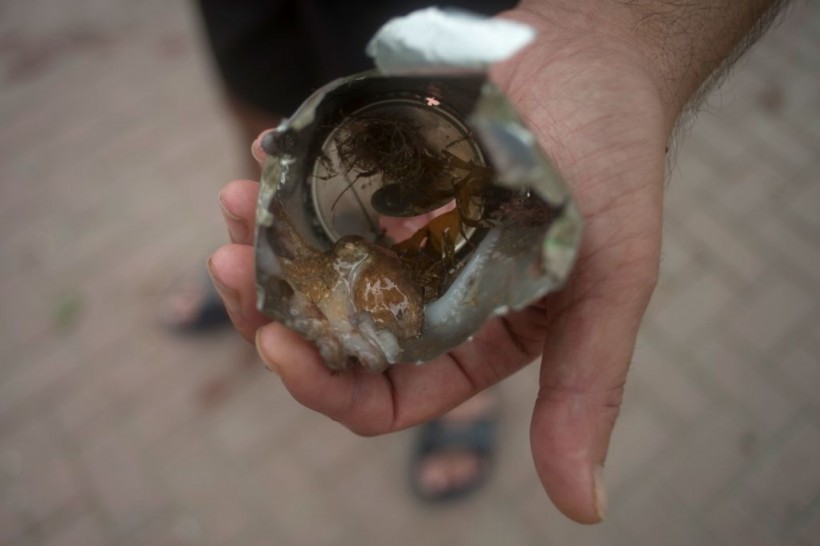Researchers from Brazil conducted a systematic review of 261 underwater images of octopuses increasing interaction with litter on the ocean floor. MailOnline reported that the shocking images reveal that cephalopods use trash like cans, bottles, and plastic cups, for shelter instead of seashells.
Octopuses are well known to scour the ocean floor for objects they can hide to protect themselves. But the increasing water pollution has also given them more access to human waste and they have started using them as shelter and laying their eggs. The team is concerned that by doing so, octopuses are exposing themselves to fatal toxic compounds.

A diver shows an octopus inside a can of beer after collecting plastic waste and other items at the San Nicolas beach in Adra near Almeria on July 4, 2020.
Human Waste Becomes Alternative Forms of Protection
Divers and scientists have observed octopuses laying their eggs on plastics, bottles, ceramic pots, pipes, rusted cans, or abandoned fishing gear on the ocean floor. According to Science Alert, the review has tallied24 cephalopod species that have made human trash their homes.
Researchers wrote in their study, titled "In an Octopus's Garden in the Shade: Underwater Image Analysis of Litter Use by Benthic Octopuses," published in the journal Marine Pollution Bulletin, that many cephalopods in areas where human tourists have collected many seashells are forced to adapt or perish that is why human waste has become useful alternative forms of protection.
So sad to see this baby octopus living in garbage ! #octopus pic.twitter.com/PAGbohud8O
— Alec Rolf (@AlecinMD) September 8, 2016
Newly-described species like the pygmy octopus (Paroctopus cthulu) in Brazil have only been observed living in the litter, and no official records yet of them residing in natural items, such as seashells, probably because of the lack or scarcity of that material. Instead, they are mostly seen in beer cans thrown by tourist boats.
Some divers who volunteer to clean up marine waste often do not realize that these cans contain hiding octopuses inside. Due to that, their presence on dive boats after such efforts has become common.
Aside from them, the most recorded octopus species that interacted with human waste seemed to be the coconut octopus (Amphioctopus marginatus). They usually cover themselves with seashells or coconut husks, but the review identified nine accounts of octopuses using human waste as protection.
Increasing Interaction With Human Waste Signal Worsening Water Pollution
The team believes that the scarcity of seashells and abundance of human waste has pushed octopuses to use them as their shelters. They noted that the easier access to underwater photography helped their research.
Sadly, the increase in interaction between the cephalopods and human trash may indicate the problems posed by the worsening marine waste. The Independent reported that the team is worried that the litter on the ocean floor where octopuses have established their habitat could expose them to toxic chemicals or heavy metals.
They pointed out a photo where an octopus was clinging to a heavily degraded battery considered a very polluting type of debris. Also, they fear that octopuses might get entangled and cause physical harm from the sharp edges.
The authors said that most of the 261 underwater images and videos they collected were gathered on social media with the permission of the original authors, while some were contributed by marine research institutions and scientists. They emphasized the importance of citizen science that provided them evidence on octopus and marine waste interaction that highlights its value for further study.
They added that the findings of the study and information from citizen science are fundamental in preventing and mitigating the impacts of litter on octopuses and identifying knowledge gaps.
RELATED ARTICLE: Watch How This Octopus Rolls Plastic Pipe Into Ocean to Save Eggs
Check out more news and information on Octopus and Water Pollution on Science Times.














